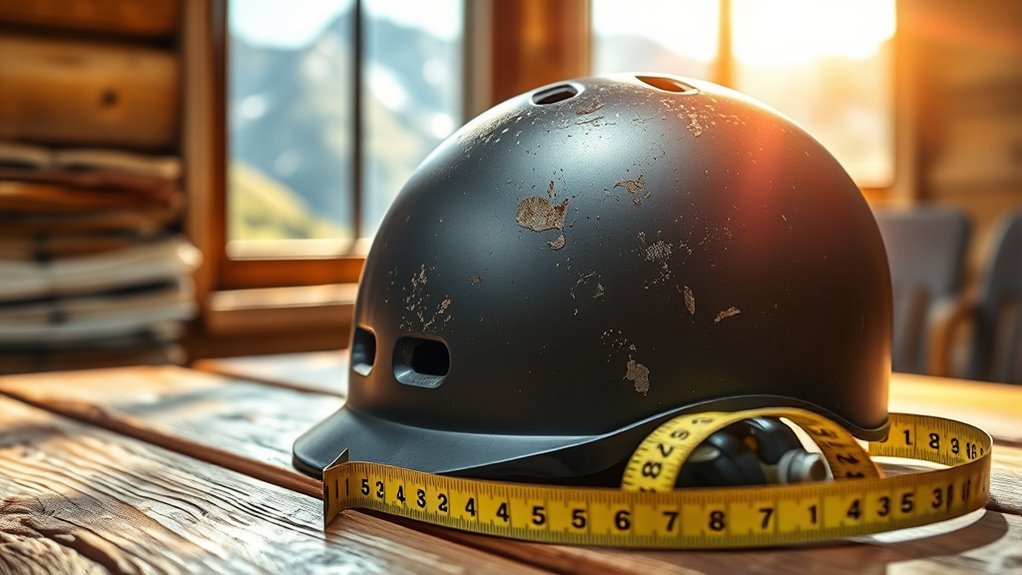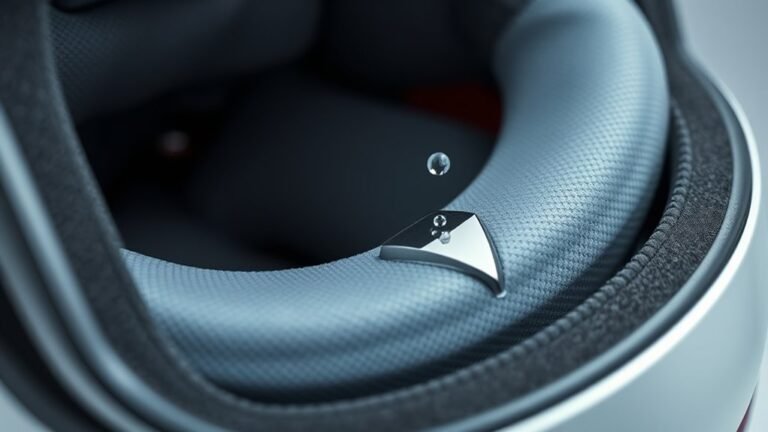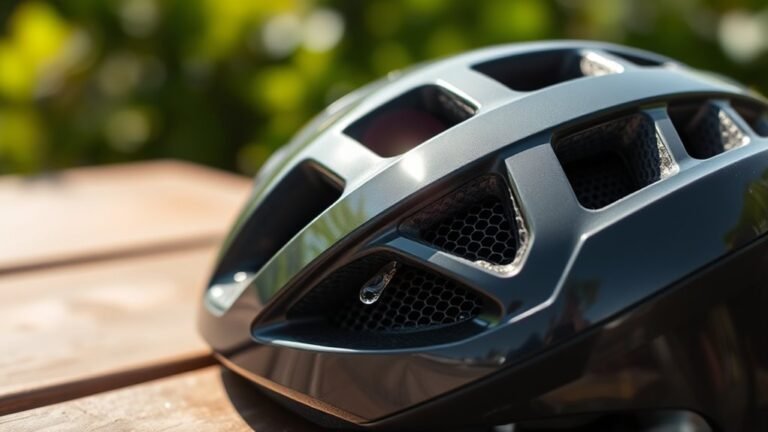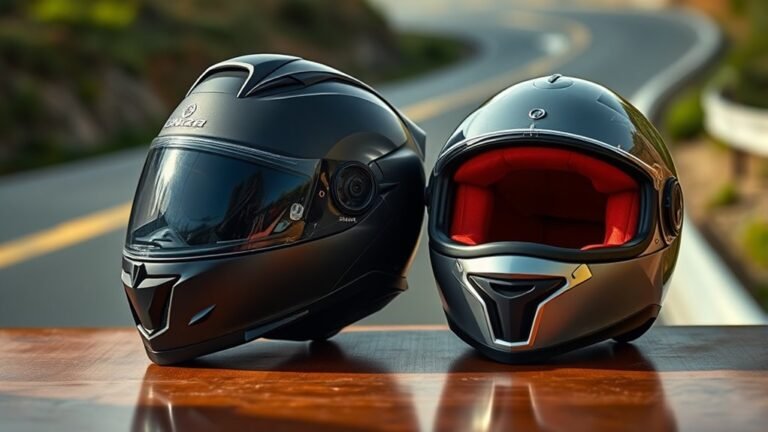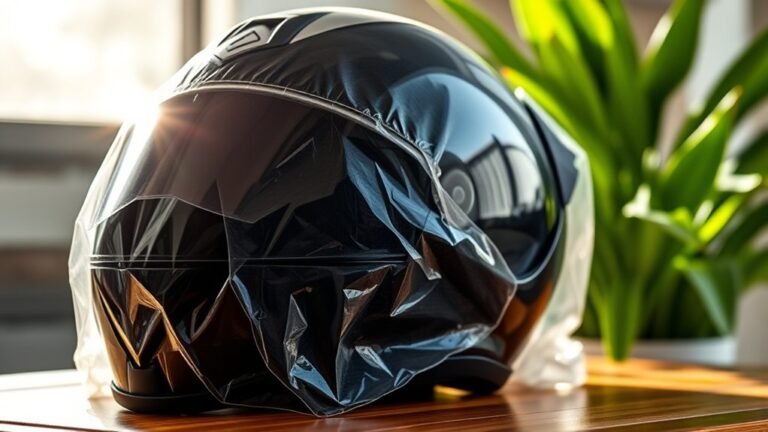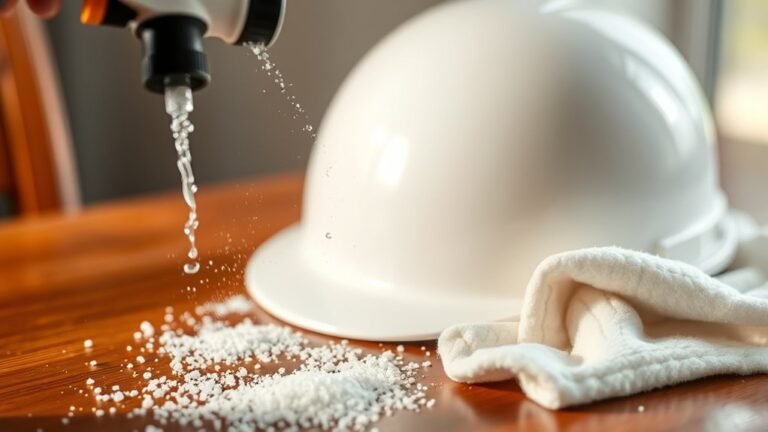When Should You Replace Your Helmet? A Guide
You should replace your helmet every 3 to 5 years, even if it looks fine. Look for signs of wear like cracks, faded padding, or frayed straps. If your helmet has been in a significant fall, replace it immediately, as its impact protection may be compromised. Always follow manufacturer guidelines, and regularly inspect your helmet to guarantee it’s in good condition. There’s more to learn about maintaining your helmet’s safety and longevity.
Understanding Helmet Lifespan
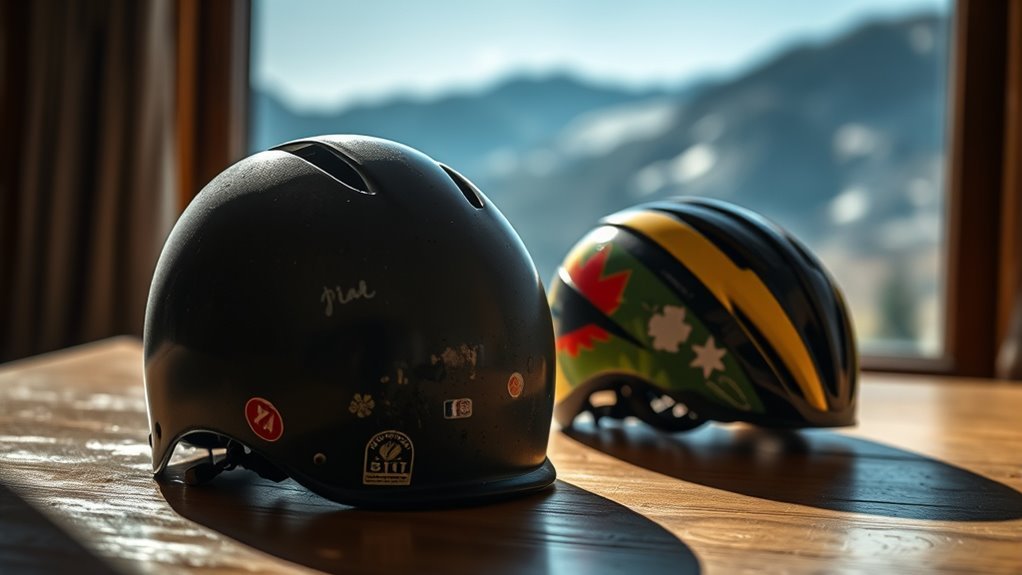
When it comes to helmet safety, understanding its lifespan is essential for protecting your head. Helmets are designed using advanced helmet materials like polycarbonate, fiberglass, and expanded polystyrene, each contributing to their effectiveness. However, the technology behind these helmets isn’t permanent. Generally, you should replace your helmet every 3 to 5 years, even if it appears undamaged. This is due to the gradual degradation of materials over time, which can compromise safety. Environmental factors like UV exposure and temperature fluctuations can also impact durability. Staying informed about the latest helmet technology can help you make educated decisions regarding your gear. Prioritizing your safety means understanding when it’s time to invest in a new helmet for ideal protection.
Signs of Wear and Tear
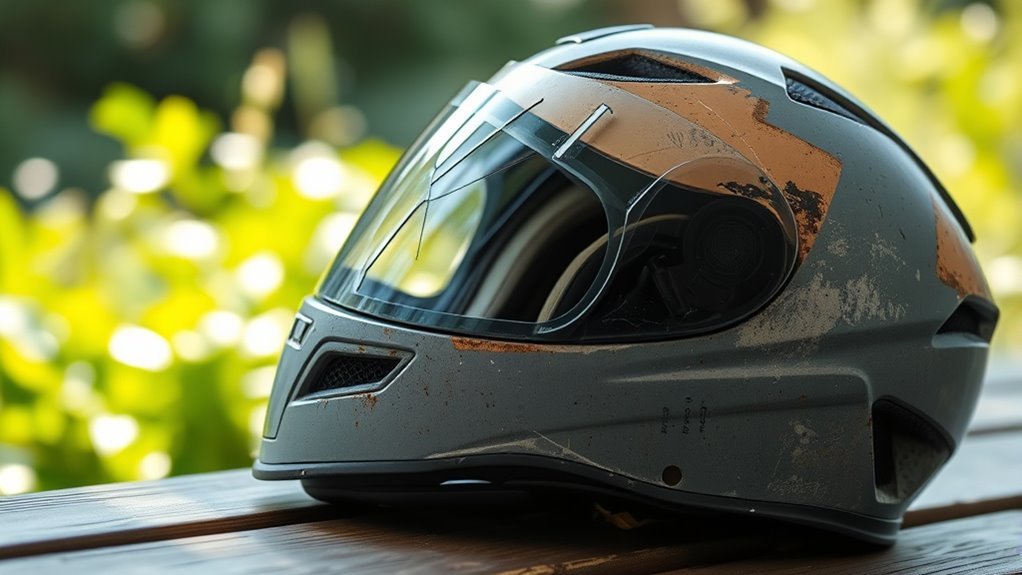
When inspecting your helmet, look for visible cracks or dents that could compromise its integrity. Additionally, faded padding is a sign that the materials may no longer provide adequate protection. Don’t forget to check the certification date; an expired certification means it’s time for a replacement.
Cracks or Dents
Visible cracks or dents on your helmet are clear indicators that it’s time for a replacement. These damages compromise helmet integrity and can greatly reduce your protection during rides. A simple visual inspection can help you assess the condition of your helmet regularly. If you spot any deformities, don’t hesitate to replace it. Your safety is paramount.
| Signs of Damage | Action Required |
|---|---|
| Cracks | Replace immediately |
| Dents | Replace if deep |
| No visible damage | Continue regular checks |
Faded Padding
After evaluating the exterior of your helmet for cracks and dents, it’s important to pay attention to the condition of the padding inside. Faded or worn padding can greatly impact your comfort and safety. If you notice the padding has lost its thickness, is crumbling, or has developed an unpleasant odor, it’s time to think about a padding replacement. Not only does worn padding reduce comfort during your rides, but it also diminishes the helmet’s ability to absorb shock effectively. When you’re seeking freedom on the road or trail, don’t let degraded padding hold you back. Make comfort considerations a priority; a well-padded helmet guarantees you stay focused on the journey ahead, knowing you’re protected.
Expired Certification
Even if your helmet looks fine on the outside, it’s essential to check its certification date and any signs of wear and tear that may indicate it’s time for a replacement. Helmets have expiration dates based on safety standards, and using one with expired certification can jeopardize your safety. Here are three key signs to watch for:
- Certification Updates: Verify your helmet meets current standards; outdated helmets may not provide adequate protection.
- Visible Damage: Look for cracks, dents, or deep scratches that compromise structural integrity.
- Age and Usage: If your helmet’s over five years old or has seen frequent use, consider replacing it.
Don’t take chances with your safety; staying informed about expired standards helps keep your rides enjoyable and secure.
The Impact Test: When to Replace After a Fall
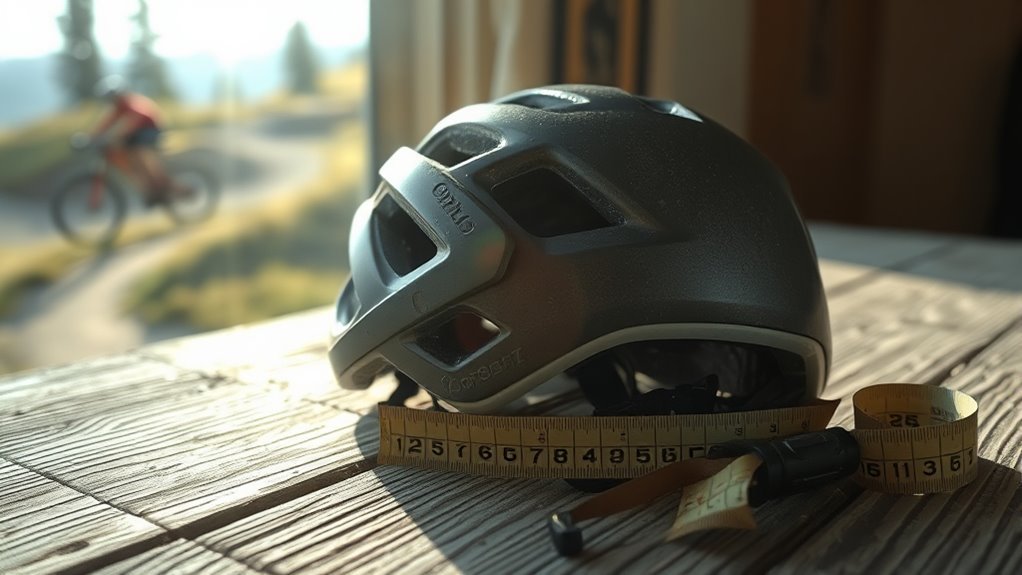
When you take a fall while cycling, skiing, or engaging in other sports, it’s crucial to assess the condition of your helmet immediately. Start with a fall analysis; if you’ve hit your head, there’s a strong chance your helmet’s impact absorption capabilities have been compromised. Even if the helmet looks fine externally, the internal foam may have been crushed, reducing its effectiveness. Helmets are designed to withstand a single significant impact, and using one after a hard fall could put you at risk in future accidents. If you suspect any damage, replace your helmet without hesitation. Prioritizing your safety not only enhances your freedom on the slopes or trails but guarantees you’re protected during every adventure.
Age Matters: How Old Is Too Old?
How long have you had your helmet? If it’s over five years, it’s time to assess its condition. Helmet technology and material advancements have rapidly evolved, making older helmets less effective in protecting you. Here are three key factors to evaluate:
- Visible Damage: Cracks, dents, or worn straps can compromise safety.
- Impact History: If you’ve had a significant fall, even if the helmet looks fine, replace it.
- Material Degradation: Over time, the foam and outer shell can break down, reducing effectiveness.
Manufacturer Guidelines and Recommendations
Many helmet manufacturers provide specific guidelines on when to replace your helmet, reflecting the latest research and technology. Typically, these manufacturer recommendations suggest replacing your helmet every 3 to 5 years, regardless of visible wear. This timeframe aligns with evolving safety standards that consider the materials’ degradation over time. If you’ve been in an accident or notice any cracks, it’s essential to replace your helmet immediately, as even minor damage can compromise safety. Always refer to your helmet’s owner manual for detailed information, as different brands may have unique recommendations. Staying informed guarantees your protection remains effective, allowing you to enjoy your adventures with confidence and peace of mind. Prioritize your safety—it’s worth the investment.
Storage and Care: Keeping Your Helmet in Good Shape
To keep your helmet in good shape, proper cleaning and storage are essential. Use gentle cleaning techniques to avoid damaging the materials, and always store your helmet in a cool, dry place away from direct sunlight. By following these practices, you can extend the life of your helmet and guarantee it continues to protect you effectively.
Proper Cleaning Techniques
Although you may not think about it often, keeping your helmet clean is essential for its longevity and effectiveness. Regular cleaning not only removes dirt but also helps maintain the integrity of your helmet. Here are some proper cleaning techniques to follow:
- Use mild cleaning materials: Avoid harsh chemicals. A mix of warm water and mild soap works wonders.
- Clean frequency: Aim to clean your helmet every few rides, especially after exposure to sweat or mud.
- Dry properly: Always air dry your helmet, avoiding direct sunlight or heat sources to prevent damage.
Ideal Storage Conditions
After guaranteeing your helmet is clean, proper storage plays an essential role in maintaining its condition. Store your helmet in a cool, dry place, away from direct sunlight. High humidity levels can lead to mold and deterioration, while temperature extremes can compromise the integrity of the materials. Ideally, you should keep it in a temperature-controlled environment, avoiding garages or attics where conditions fluctuate. If you ride often, consider using a dedicated helmet bag to shield it from dust and potential impacts. Always ascertain your helmet isn’t resting on its visor, as this can warp its shape. By following these storage guidelines, you’ll help prolong your helmet’s life, keeping it ready for your next adventure.
Upgrading for Improved Safety Features
As you consider your safety gear, upgrading your helmet for improved safety features can greatly enhance your protection on the road or trail. Modern helmets incorporate advanced materials and cutting-edge safety technology that can make a significant difference. Here are three key upgrades to look for:
- Multi-directional Impact Protection System (MIPS): This technology reduces rotational forces during impacts, offering better brain protection.
- Enhanced Ventilation: Improved airflow keeps you cool, allowing longer rides without compromising safety or comfort.
- Lightweight Construction: Helmets made with advanced materials are lighter yet provide superior protection, ensuring you don’t feel weighed down.
Investing in these features not only boosts your safety but also enhances your overall riding experience. Stay free, stay safe!
The Importance of Regular Inspections
Regular inspections of your helmet are essential to confirm it remains effective in protecting you during rides. By conducting regular checks, you guarantee that any signs of wear or damage are caught early. Look for cracked shells, frayed straps, or compromised padding—these issues can greatly reduce your helmet’s protective capabilities. Safety inspections not only help maintain your helmet’s integrity but also give you peace of mind while riding. Remember, a helmet’s lifespan isn’t solely determined by time; it’s also about how well it’s maintained. Make it a habit to inspect your helmet before each ride and replace it if you notice any concerning changes. Prioritizing these inspections keeps you safer, allowing you to enjoy the freedom of the open road with confidence.
Frequently Asked Questions
Can I Paint or Customize My Helmet?
You can paint or customize your helmet, but hold on—there are safety considerations you need to keep in mind. Helmet modification can compromise its integrity if you use the wrong materials or methods. Verify any paint or decals are non-toxic and won’t affect the helmet’s protective features. Always check with the manufacturer for guidelines before you release your creativity. Your safety should never take a backseat to style, so proceed with caution!
Are There Specific Helmets for Different Sports?
Yes, there are specific helmets designed for different sports, and it’s essential to use the right one. For instance, football helmets are engineered to absorb impact during tackles, while cycling helmets are lightweight and focus on ventilation and aerodynamics. Each design addresses unique safety needs and performance factors, so you shouldn’t use a football helmet for cycling. Choosing the right helmet guarantees your safety and enhances your overall experience in any sport.
Can Helmets Be Recycled After Replacement?
Yes, helmets can be recycled after replacement, but don’t expect them to throw a party for you! Helmet recycling promotes eco-friendly disposal, so you’re not just tossing it in a landfill. Many manufacturers provide programs for recycling, ensuring your helmet gets a second life instead of just gathering dust. Just check local guidelines, as recycling options may vary. After all, saving the planet while being safe is the ultimate freedom, isn’t it?
How Do I Properly Clean My Helmet?
To properly clean your helmet, start by removing any removable padding and wash it with mild soap and water. For the outer shell, use a soft cloth or sponge with warm, soapy water, avoiding harsh chemicals. Rinse thoroughly and air dry. Regular helmet maintenance includes checking for cracks or damage as you clean. Following these cleaning techniques guarantees your helmet stays in top condition, providing the protection you need while enjoying your freedom.
What Should I Do With a Damaged Helmet?
A damaged helmet’s like a cracked shield—you can’t trust it anymore. First, inspect it thoroughly for any cracks, dents, or structural weaknesses. Look for helmet replacement signs like wear and tear on padding or straps. If you spot any damage, it’s time to retire it. Don’t take chances with safety; a compromised helmet won’t protect you properly. Always prioritize your well-being by replacing it with a new, reliable helmet.
